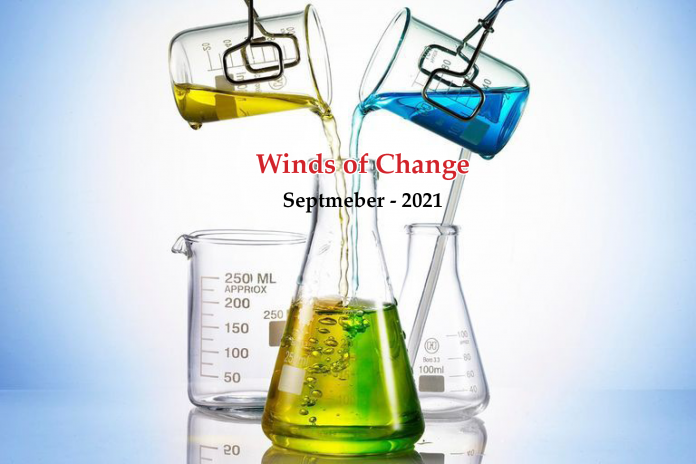Global wind power capacity increased by 53% in 2020 but has to triple in the coming decade if global warming has to be limited to 2oC above pre-industrial levels. This month’s column examines some trends in the wind power industry as it jostles to assume pole position in the race to Net Zero by 2050.
The energy residing in wind has been put to use since time immemorial. The first wind turbine to produce electricity was built in 1887; it generated 12 Kw power. The total installed wind power capacity now is 742 GW and it accounts for more than 6% of the global electricity supply, eliminating in the process the emission of 1.1 billion tonnes of carbon dioxide every year. Wind power has one of the lowest carbon footprint compared to other energy sources. A recent study has determined that the emissions from wind power are as low as 11 grams of carbon dioxide per kWh of power, compared to 44 g/kWh for solar power, 450 g/kWh for gas-fired power and 1000 g/kWh for coal-based power. The carbon footprint of wind power is 99% lower than coal-fired power, 98% lower than gas-fired power and even 75% lower than solar power. With a record accretion of 93 GW of fresh capacity, 2020 was the best year for the wind power industry. 75% of the new installations were in USA and China. It was a 53% year-on-year increase. But if we have to reach the net zero target by 2050, the wind power capacity has to grow three times faster over the next decade. Several scenarios have projected that by 2050 the wind power capacity would be ten times bigger than the present level.
HAWT and VAWT
There are two basic configurations in wind turbines based on the orientation of the blades with respect to the wind stream. The most common configuration is the Horizontal Axis Wind Turbine (HAWT), in which the axis of rotation of the blades is parallel to the wind. However, Vertical Axis Wind Turbine (VAWT) is gathering much attention these days because of several advantages. VAWTs are low on maintenance because of fewer components. They can also be scaled down for installation on rooftops of residences. When operated in isolation, a VAWT has a lower efficiency of 35% – 40% as against 50% for HAWT. A recent study in a large wind farm reveals that the turbulence generated downstream of the front row of turbines can have a detrimental effect on the performance of turbines is subsequent rows. The efficiency of the turbines in the back rows falls as low as half of those in the front rows. A computer simulation shows that if the back row turbines were changed from HAWT to VAWT design, the output of the VAWT turbines is 15% more than when operated in isolation. The synergy in the performance of VAWTs depends on how they are arranged and is thus a crucial factor in the windfarm layout. VAWTs are cheaper to build and the recent findings have created a buzz that they could be the future of wind power.
Bladeless
Even as experts are taking positions on the HAWT vs VAWT debate, a bladeless revolution is silently stirring things up in the wind power industry. This breathtaking innovation does away with blades completely and relies on the principle of vortex shedding to harvest energy from wind. The bladeless “turbine” has only a single tall mast made of a lightweight material. As wind flows around the mast, vortices are shed. When the frequency of the vortex shedding matches with the structural frequency of the mast, it begins to oscillate and enters into resonance with the wind. This vortex-induced vibration is used to generate electricity in an alternator. The frequency of vortex shedding is a function of wind velocity and every structure has its own natural vibration frequency. The innovation is in the development of a self-synchronisation system, by which the structural rigidity of the oscillating mast is varied automatically so that it stays in resonance with the wind. A Spanish start-up backed up by EU funding has developed 100 W prototypes which are currently under field testing.
3D Printing
3D printing promises to revolutionise the design and manufacture of wind turbine blades. For Haliade-X, the world’s most powerful wind turbine, GE is partnering with two German companies to develop the world’s largest 3D printer. GE plans to use the 3D printer to produce sand moulds for casting the various complex components that go into the manufacture of the nacelle of a wind turbine. The 3D printed moulds are expected to produce castings that weigh a whopping 60 tonnes and are as big as 9.5 metres in diameter. 3D printing will bring many potential benefits for the manufacture of wind turbine blades. The castings will be of high quality with improved surface finish. Material costs and machining time will be lower. A very significant advantage is the reduction in the manufacturing time, which will dramatically crash the schedules for windmill projects. Most importantly, 3D printing obviates the need to transport the monstrous blades over long distances from a central manufacturing location and lowers the carbon footprint of wind power projects.
Circular Economy
A lot of material goes into building and erecting wind power projects – steel, aluminium, fibreglass, carbon fibre, concrete, copper and even exotic metals like neodymium which are used in the magnets. Many wind turbines are rapidly reaching obsolescence and the end of their useful life. They have to be replaced by more efficient new generation turbines. 1.5 GW of offshore wind capacity is estimated to be decommissioned by 2030 and 13 GW by 2040. Whereas 85% of a wind turbine consisting of steel, copper and electronics can be reused or recycled, the blades pose a massive challenge. Since the various parts of the turbine blade are subjected to diverse kinds of cyclic stresses, it is imperative to use different materials for different parts of the blade. Composites of wood, carbon fibre and FRP are used in the manufacture of wind turbine blades and it is not economically feasible to separate the components for recycling. Much work is underway to prevent the turbine blades from ending up in landfills and increase their recyclability. Earlier this month, Siemens Gamesa launched the first fully recyclable wind turbine blade. The company has developed a special resin that can be efficiently separated from other components at the end of the useful life of the blade. The first lot of six fully recyclable 81-metre-long blades have already been manufactured by the company at their plant in Denmark. By early adoption of circular economy practices, the wind power industry is poised to become the spearhead for the transition to Net Zero.
Last Word
As per the latest report of Global Wind Energy Council, India with 39 GW of wind power capacity ranks 4th globally behind China (288 GW), USA (122 GW) and Germany (63 GW). India’s capacity is entirely land based, but the government has recently announced a target of setting up 30 GW of offshore wind projects along the 7600 km coastline. Winds of change are gathering force.
Readers’ responses may be sent to:
k.sahasranaman@gmail.com or
chemindigest@gmail.com

































